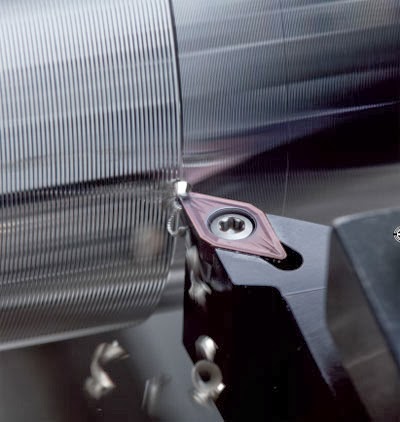
A common approach to finish turning involves the use of light depths of cut. In many cases, however, heavier depths of cut can help optimize finishing processes.
When improving a finishing operation, changing feed rate is rarely an alternative. Feed often is tied to a surface finish (Ra/Rz) requirement, following cutting tool makers’ charts that list specific combinations of nose radius and feed rate needed to achieve desired surface finish. However, even if feed rates are essentially fixed, altering the depth of cut can help overcome the special issues of finish turning.
Because finishing operations often generate thin, hard-to-control chips, the first consideration is choosing a chip groove geometry. The geometries are designed for different applications. Seco, for example, offers MF2 and M3 chipbreakers for fine and light-to-medium duty cuts in steels. Every chip control geometry has an optimal working window and it is important to use cutting parameters that fit. For example, if the working area of the insert’s chip groove is 0.011" - 0.020" depth of cut, but finishing is performed at 0.010" depth of cut, chip control won’t be as effective as it could be.
Even with the correct chip groove, surface finish may be unsatisfactory. The cause can be premature insert wear resulting from the combination of a light depth of cut and a large nose radius.
When turning with a very light (for example, 0.010") depth of cut and a large (e.g. 0.031") nose radius, chips roll over the nose radius and onto the land area at the periphery of the insert edge. In a high-carbon steel, that contact can promote crater wear on the land and thereby decrease the insert’s ability to produce a smooth finish.
A heavier depth of cut will form the chip beyond the nose radius. With a 0.031" nose radius, for example, using a 0.040" depth of cut will direct the chip over the flank of the insert and cause it to make contact with the tool in the gullet behind the land, where crater wear is more acceptable.
An overly light depth of cut will produce uncontrolled chips that will form stringers or a nest that can wrap around the tool and scratch the workpiece. A heavier depth of cut tends to help chips roll up and break, but most shops don’t finish at a 0.040" depth of cut with a 0.031" nose radius. The answer can be use of a smaller nose radius for finishing applications. A shop may use a CNMG 432 (1/32" or 0.03125" nose radius) in roughing and then a CNMG 431 (1/64" or 0.01562" nose radius) for finishing. The smaller nose radius paired with a lighter depth of cut will direct the chip to the insert flank because the depth of cut is larger than the tangency of the nose radius.
Manipulating depth of cut can also control cutting forces and help minimize chatter. There are three categories of cutting force in a turning operation. Axial force is generated when feeding along the z-axis towards the machine chuck. The force is into the strongest areas of the machine and workpiece and is an element of a stable cut. A second force, called tangential force, is the pressure on the top rake of the insert as it is cutting. The force increases as the part spins faster and generally is not a problem.
The third force is radial force. It involves x-axis pressure and the insert pushing off the part or the part pushing off the insert. Radial force can promote chatter or vibration and generate a wavy finish.
The goal is to maximize axial force and minimize radial force. If the tool is rigid and the part is large in diameter and well supported, the negative effect of radial force is small. But the situation is different when turning, for example, a 16"-long, 1"-diameter shaft. With a slender, long part that is not well supported in the center, the beginning of the cut near the tailstock and the end of the cut near the chuck are fairly rigid and solid, but vibration occurs in the center because there is no support. Radial forces really come into play in that scenario. For example, with a 0˚ or -5˚-lead angle insert that has a 0.015" nose radius, turning at a 0.012" depth of cut over a 2.5" length of cut will produce a taper of roughly 0.0004" per inch. However, increasing the depth of cut to 0.022" generates negligible taper because the depth is 0.007" past the tangency line of the nose radius. The nose radius is out of the cut and doesn’t generate significant radial force. In other words, the axial force is greater than the radial force. Summing it up, as depth of cut decreases, radial force at the nose radius grows. To reduce chatter, generally use the smallest nose radius possible and increase the depth of cut. |